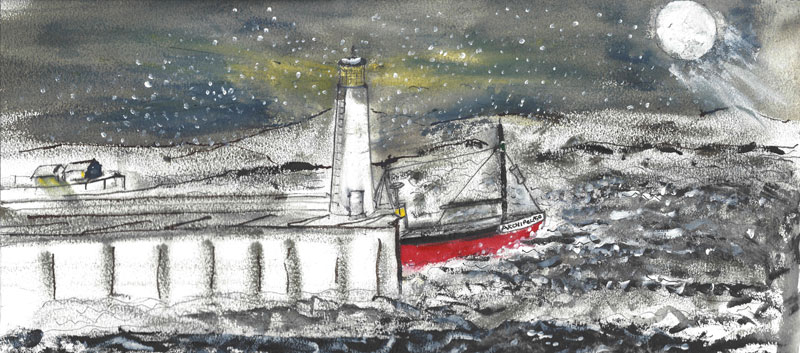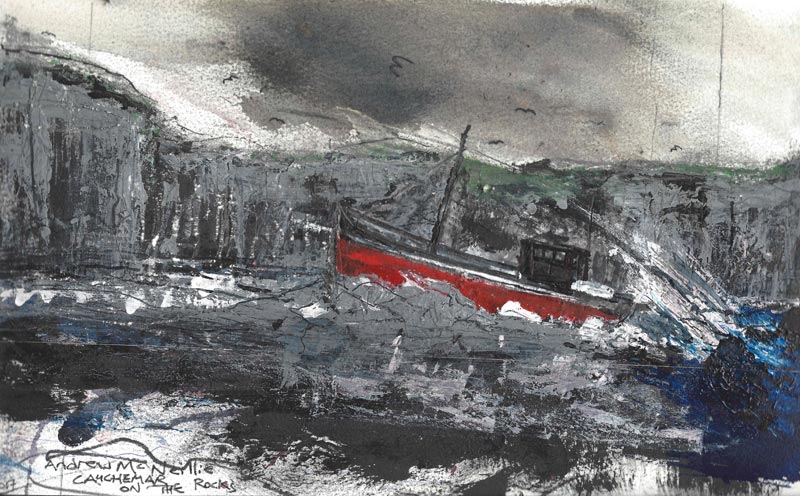
If you’ve ever wondered what all this is about, track down Jos Smith’s essay ‘Fugitive Allegiances. The Good Ship Archipelago and the Atlantic Edge’ in Coastal Works (OUP, 2017) edited by Nicholas Allen, Nick Groom, and Jos Smith himself. It gives the richest and most inspired and inspiring account of the project and its origins you could wish for.
Rarely would that same good ship put in at Cill Rónáin, Inis Mór, in August, at the height of the tourist season. But it did this time. And it rained Biblically for three and a half days out of five, with one truly fair day in between, as just deserts for such folly. The place was heaving with half-drowned visitors. ‘Go east, young man,’ I advised myself, away from the tourist trail. So I devoted my stay to exploring a part of the island I’ve tended to neglect in the past. Usually I visit out of season and I’m drawn west to my old haunts. (Next year in November, they’ll be old haunts of fifty years ago. I will head there again, to make landfall 3 November, in foul weather, I hope.)
I can’t claim to know the southeast well. But at least I know where to find it. J. M. Synge drew me to it but in a puzzling way. As I always do I took his The Aran Islands with me, in the little pocket-sized World’s Classics edition (Four Plays and The Aran Islands, 1962) that had been my companion during my original sojourn on Inis Mór (1968-69) – together then with The Plays & Poems of J. M. Synge (Methuen, 1963), a school prize I chose and was awarded in 1965. Both are treasured ‘comfort books’ now, layered with personal association, as also in my bag this trip is Richard Murphy’s Sailing to an Island (1963), in the copy I’d bought in my youth, in 1965, at what was Green’s Bookshop on Dublin’s Nassau Street. (I will be back in Dublin on the Murphy trail on 21 September at an event at Poetry Ireland’s HQ in Parnell Square, in celebration of his 90th birthday.)
On the evening of his arrival on the island, having first walked along the high road to the west, Synge had gone out to the east, beyond Cill Éine and Iaráirne ‘to a long neck of sandhills that runs out into the sea towards the south-west’. Of course the extensive dunes lie to the island’s east, at its southern end. Along the road Synge met ‘a boy and a man’ and asked them if there were any trees on the island. They held ‘a hurried consultation in Gaelic’ at the end of which the man asked if by ‘tree’, Synge meant ‘bush’ – if so, the man told him ‘there were a few in sheltered hollows to the east.’ The bushes or trees, such as they were, lay then, as they do now, to the west, at Cill Mhuirbhigh.
What was Synge thinking? Was he disorientated? I confess to not noticing this glaring curiosity until recently, more or less on the eve of my visit. It’s the kind of thing we often don’t see as we read. As far as I know, and that might well be not far enough, no one has drawn attention to it before. I apologise if I’m telling you what you know already.
I checked through all the editions of The Aran Islands I own, including the OUP Collected Works (vol. II Prose, 1966), back to the 1912 Maunsel Edition (in which I first read it). All give the same misdirection. So was it a mistake by Synge or by his original editor and or printer? It was I believe one or other of the latter, or both, and then perpetuated by subsequent editors, even at OUP. For in his little essay ‘An Impression of Aran’ (Manchester Guardian, 24 January 1905, reprinted in Nicholas Grene’s invaluable J. M. Synge Travelling Ireland. Essays 1898-1908, Lilliput Press, 2009), Synge makes no mistake: the sand-hills run ‘out into the sea towards the south-east’ and the bushes or trees grow in the west. He knew what he was talking about.
This is surely not the place for such a piece of trivial editorial pedantry, but there it is. I’ve got it out of my system. Or how trivial is it? I like a book about a place to know the place it is about. It is an editor’s job to leave no stone unturned. But here were two left unturned for more than a century. I like east to be east and west to be west, old-fashioned as that might be, never the twain to meet.
Otherwise I dreamt wildly during my nights on the island, as the image above ‘Winter Tide: The Last Voyage’ suggests – never say worst, never say last? think what became of the Pequod. It’s a vision I had of setting out, slipping harbour in search of Archipelago 12 – which I will do in December, and I hope not end in a ‘Cauchemar on the Rocks’ as portrayed below. Or even worse, adrift with only Queequeg’s coffin (still less my own) to keep me afloat. Though ‘Call me Ishmael,’ has ever been my cry.

